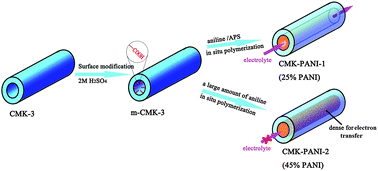Controlled synthesis of polyaniline inside mesoporous carbon for electroanalytical sensors
Abstract
A novel electroanalytical system was developed using polyaniline (

* Corresponding authors
a
State Key Laboratory of Metal Matrix Composites, Shanghai Jiao Tong University, 800 Dongchuan Road, Shanghai, P. R. China
E-mail:
smzhu@sjtu.edu.cn, zhangdi@sjtu.edu.cn
Fax: +86-21-34202749
Tel: +86-21-34202584
b Faculty of Engineering, University of Wollongong, Wollongong, NSW, Australia
c Department of Chemistry, College of Science, Shanghai University, Shanghai, P. R. China
A novel electroanalytical system was developed using polyaniline (

 Please wait while we load your content...
Something went wrong. Try again?
Please wait while we load your content...
Something went wrong. Try again?
S. Zhu, J. Gu, Z. Chen, J. Dong, X. Liu, C. Chen and D. Zhang, J. Mater. Chem., 2010, 20, 5123 DOI: 10.1039/B925287H
To request permission to reproduce material from this article, please go to the Copyright Clearance Center request page.
If you are an author contributing to an RSC publication, you do not need to request permission provided correct acknowledgement is given.
If you are the author of this article, you do not need to request permission to reproduce figures and diagrams provided correct acknowledgement is given. If you want to reproduce the whole article in a third-party publication (excluding your thesis/dissertation for which permission is not required) please go to the Copyright Clearance Center request page.
Read more about how to correctly acknowledge RSC content.
 Fetching data from CrossRef.
Fetching data from CrossRef.
This may take some time to load.
Loading related content
